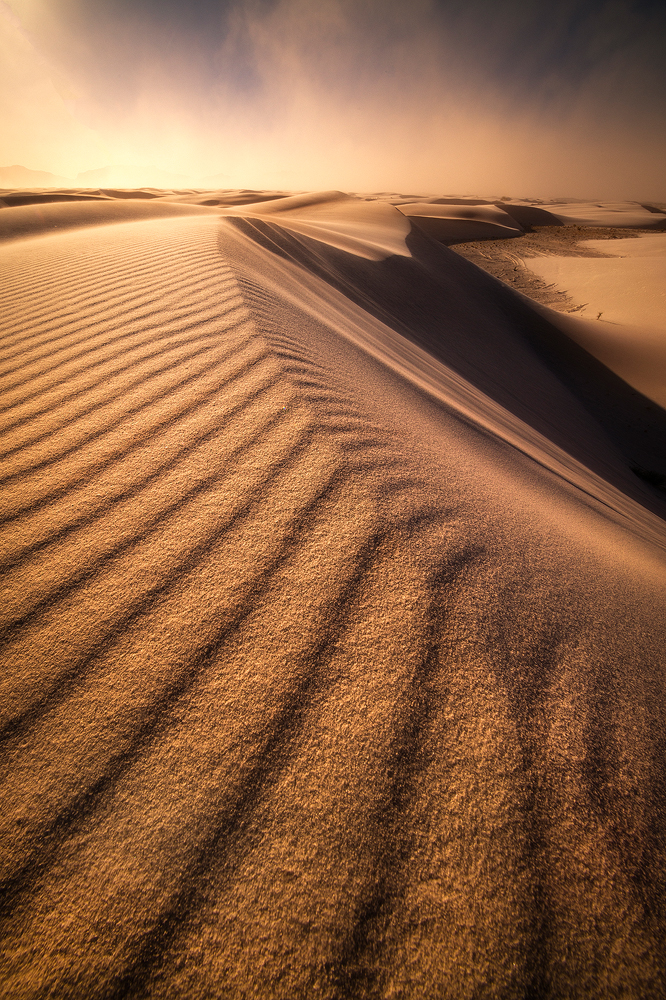
In this image I used a wide-angle lens and got as close to the foreground sand ripples to create impact. Getting low allowed me to accentuate the sand ripples as well as the contrast in light and shadow.
One of my favorite subjects when it comes to landscape photography is photographing sand dunes. The variety and the uniqueness of dunes make it a great subject to photograph. When it comes to images of dunes that resonate with viewers, the following vital elements are critical to consider: light, color harmony, and composition. Each of these concepts individually increases the chances of a successful photograph. But combining all three elements is the best way to create impactful dune images.
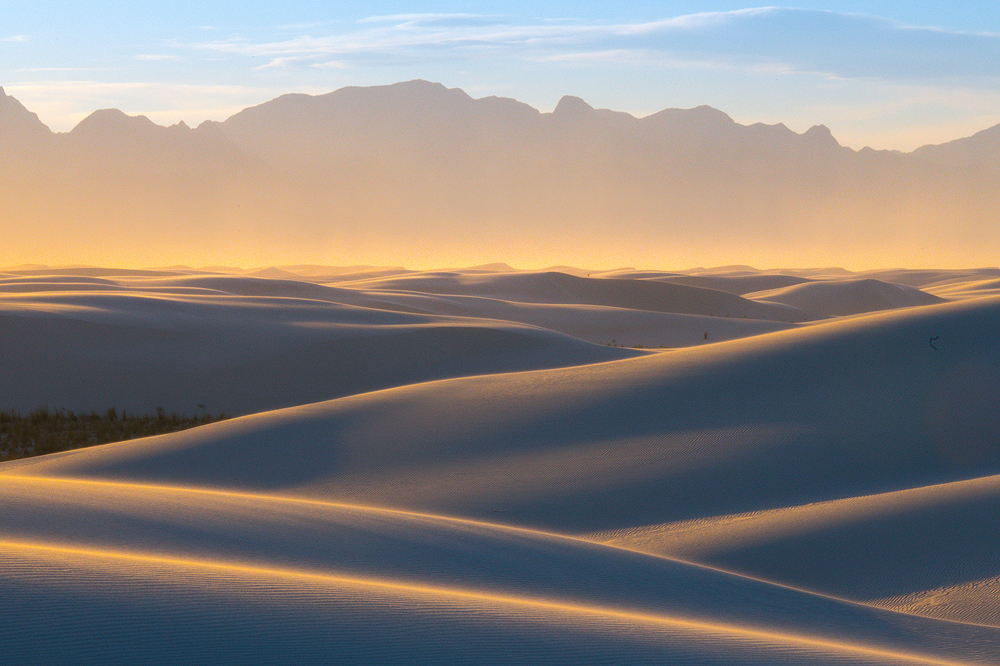
Timing of light is critical. Photographing during the magic hour of sunrise and sunset allows you to maximize light and color harmony. Overlapping layers enhances the depth as well.
In this article, I will discuss essential notions to improve your techniques when photographing dunes. It is easy to photograph the dunes, but it’s necessary to do more than photograph a dune in an standard manner. Try to capture what makes a dune unique and convey that in your image. Demonstrate to your viewer why a particular location is so unique. Pre-visualization is a fundamental step that I consistently practice whenever I am preparing to photograph. I research the Internet to find images that capture a certain mood. I figure out why that image is memorable to me. The characteristics of light, color harmony, and composition are the three concepts that stand out consistently. My objective was not to copy the photos but to capture the same striking mood and color that made those images memorable. For each photographer, those concepts will be different. It’s essential for each photographer to pre-visualize. Identify the ideas that are important to you. For me, part of the pre-visualization when photographing sand dunes was incorporating these conceptualizations.
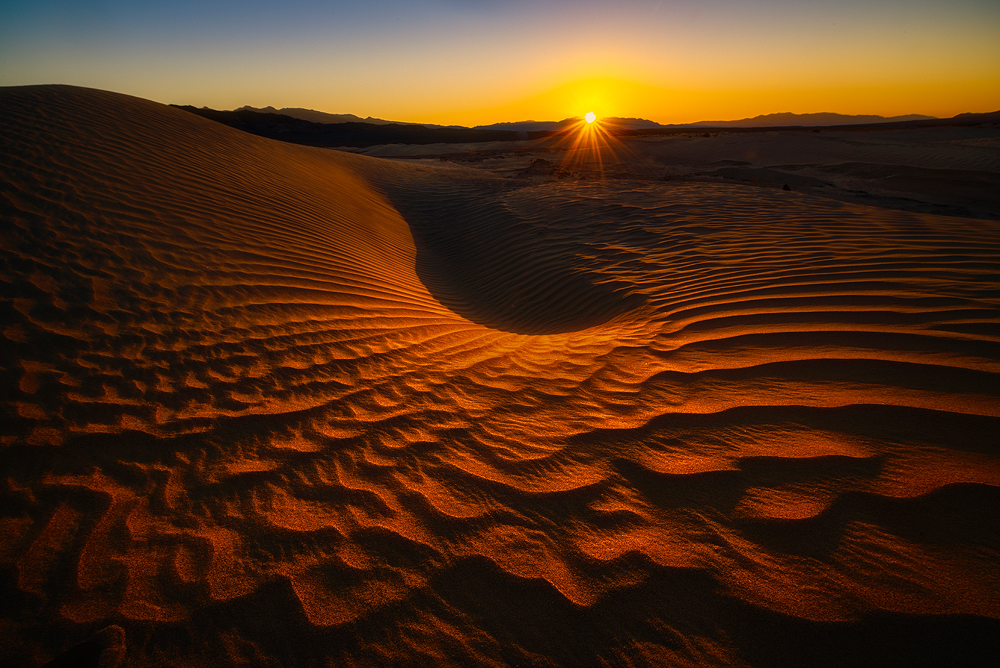
Converging lines from all both sides toward the main subject connect to the foreground to the background. its important to consider how light and shadow interact with one another.
Light
One of the essential factors to capturing great photos is to know when to photograph. Light is necessary for transforming an ordinary photo into an incredible picture. Light makes or breaks an image. The best time to capture dune photos is early in the morning at sunrise or late in the evening at sunset. In photography, we refer to this concept as the ‘magic hour.’ When the sun is close to the horizon, and the light highlights the landscape. Thus, the ‘magic hour’ is the period shortly before and after sunrise and sunset. The colors are accentuated based on the sun’s position and light. As the sun descends and gets closer to the horizon, the light becomes warmer, and the shadows become longer. The dunes reflect in warm tones, and the textures of the sand come alive. The ‘magic hour’ occurs all within a short period. Moments later, as the sun dips behind the mountain range and horizon, the dunes turn from a warm color palette to an almost immediate cool-tone. The sands reflective nature reflects the magenta – pinkish hues of the twilight sky.The soft subtle colors of twilight reflected in the dunes showcase the unique patterns and flow to the dunes themselves. The combination of the reflected color on the dunes and the designs become a thing of beauty. So, timing and the type of light is indispensable when looking to create images that stand out with impact. Not only is good light a prerequisite, but how its properties interact with each other is needed. Color Harmony is the next necessary component to create successful dune images.
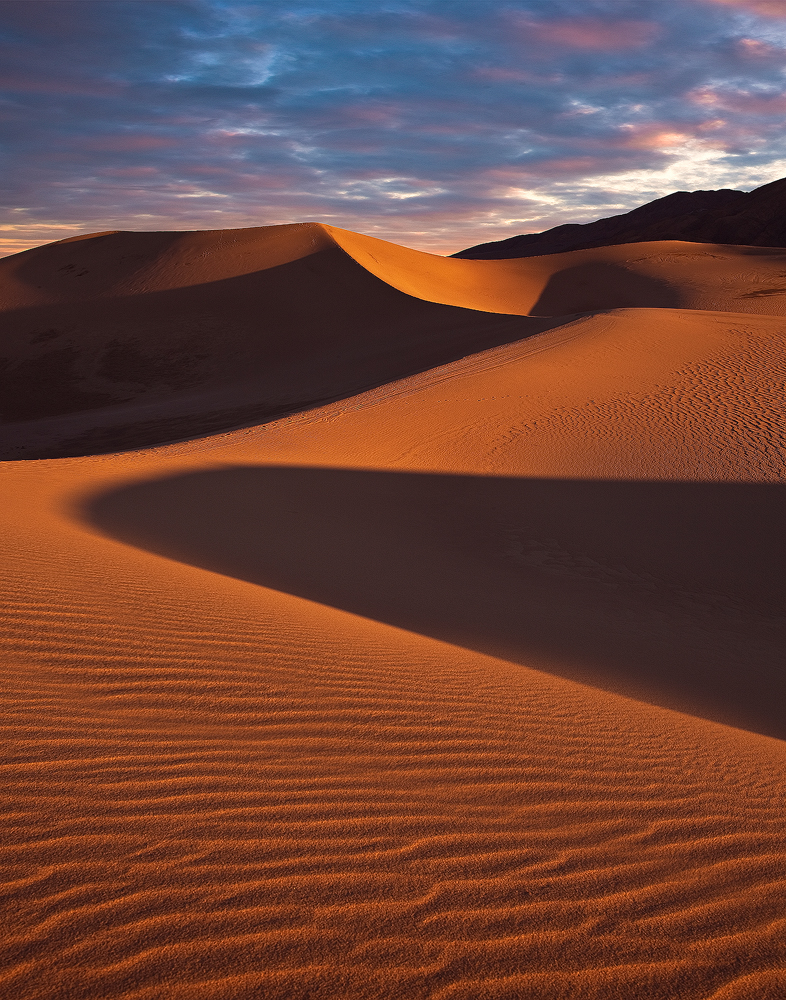
Placement of light and shadow within the composition allows more depth and color harmony to the image. I also used the S-Curve as a design template.
Color Harmony
Color harmony is one subject that often gets overlooked when it comes to creating stunning dune images. Color Harmony are two colors that face directly across from each other on the color wheel. Color theory and properties are essential to understand to become a better photographer. Based on color, an image stimulates the senses or becomes forgettable. Each color in an image has a relationship to one another. The arrangement of those colors dictates how the image is perceived.
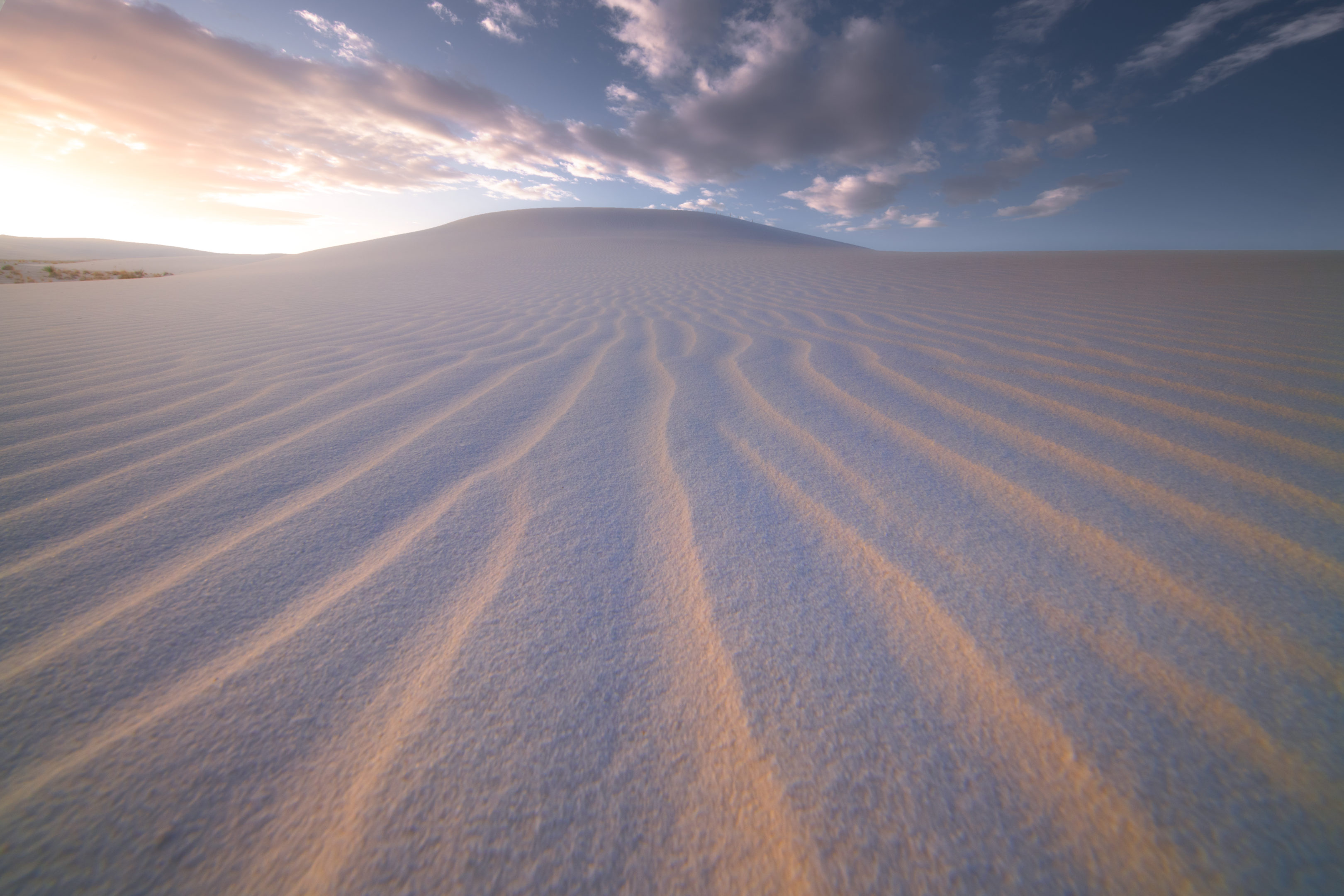
Low angle perspective allows the camera to be tilted upward and to include the sky. The cooler palette also creates a different mood.
When framing the dunes, I look for a balance of complementary colors that evoke a certain mood. When shooting around sunrise or sunset, create visual tension by including warm and cool tones throughout the image. The strategic placement of these opposing tonalities creates a juxtaposition in contrast. The interaction between the color tones creates depth and dimension. The cool shades balance the image from being too warm and thus overwhelming. It’s essential to consider color harmony for images that are mostly warm-toned. Images photographed during the twilight hour have a different color palette with mostly cooler tones. These tones range from pastel pinks to purples. The mood that conveys with twilight photography is much more subdued. Both are correct color tones when it comes to color harmony but offer very different themes. As with warmer toned images, cool-toned images benefit from incorporating a small number of warmer tones. Incorporating a hint of warm tones helps balance the overall color mood. Once you understand creative color theory and how the color properties relate to one another, your images will stand out more.
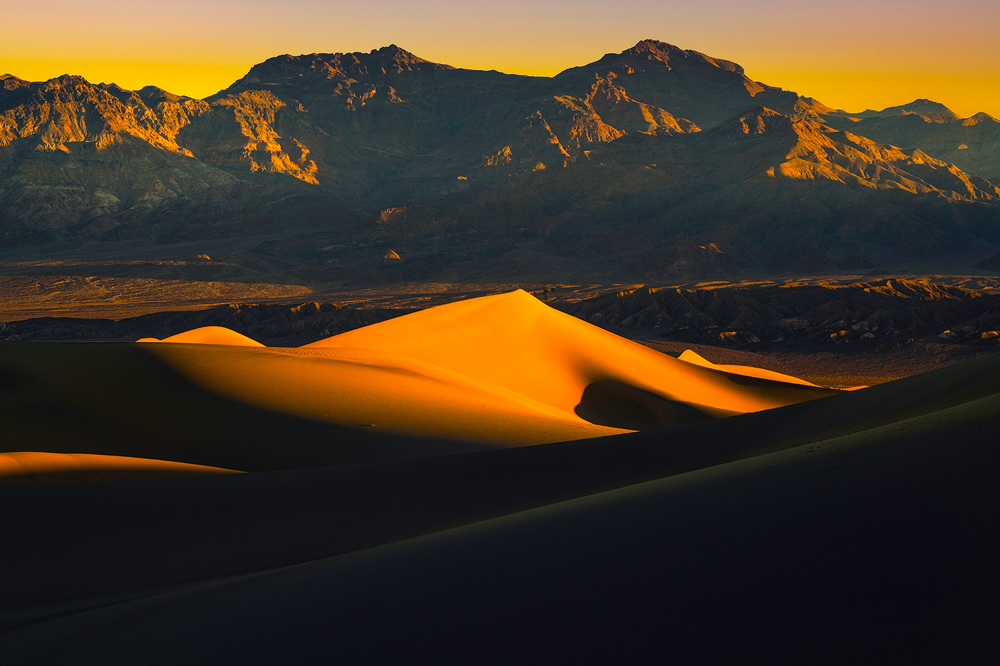
A telephoto lens allowed to frame the main subject in light and use shadow to connect the elements. Also multiple layers creates more interest in the image.
When setting up to photograph dunes, I shoot during the magic hours of sunrise and sunset. Photographing during this period allows me to take advantage of the warmer tones. I look to complement the warmer dunes or ripples with the cooler shadows within the gaps of light. The peaks of dunes receive the warm sunlight, while the backsides receive the shadows. It is essential to balance the amount of color weight displayed.
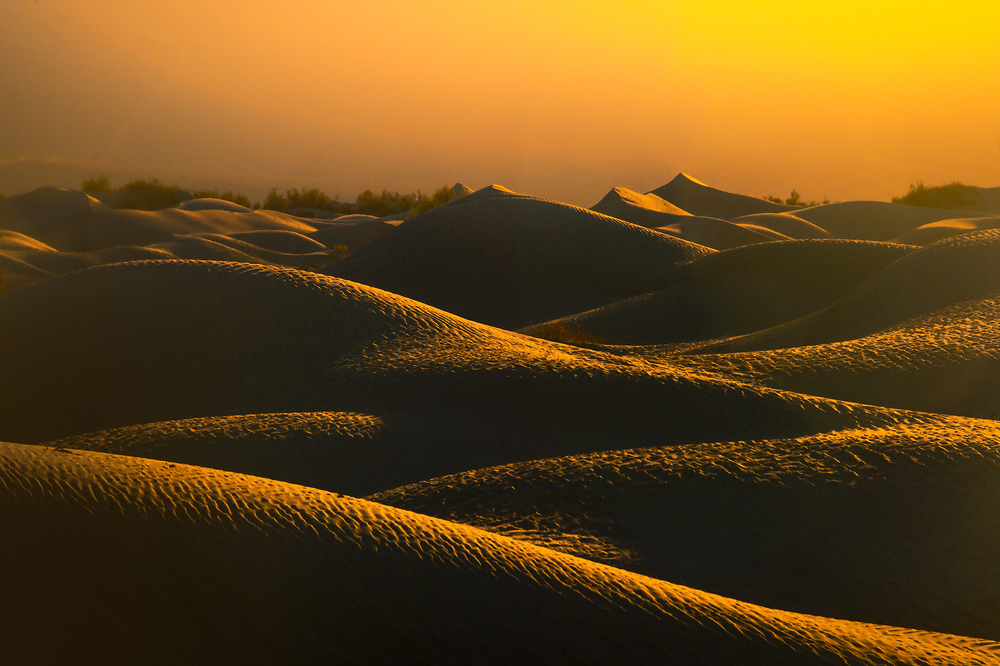
Repeating patterns of light and shadow create depth in the image. The atmospheric mist was also important in adding mood
Composition
Composition is the way lines, shapes, and colors are arranged in an image. It brings all the creative elements of your picture together in a compelling fashion. The goal is to avoid a chaotic composition. The goal is to prevent a design and bring simplicity to the chaos.
A good composition aims to create compelling arrangements that connect with the viewer. Every component within the frame supports the main subject. Anything that detracts from the image needs to be eliminated from the overall scene.
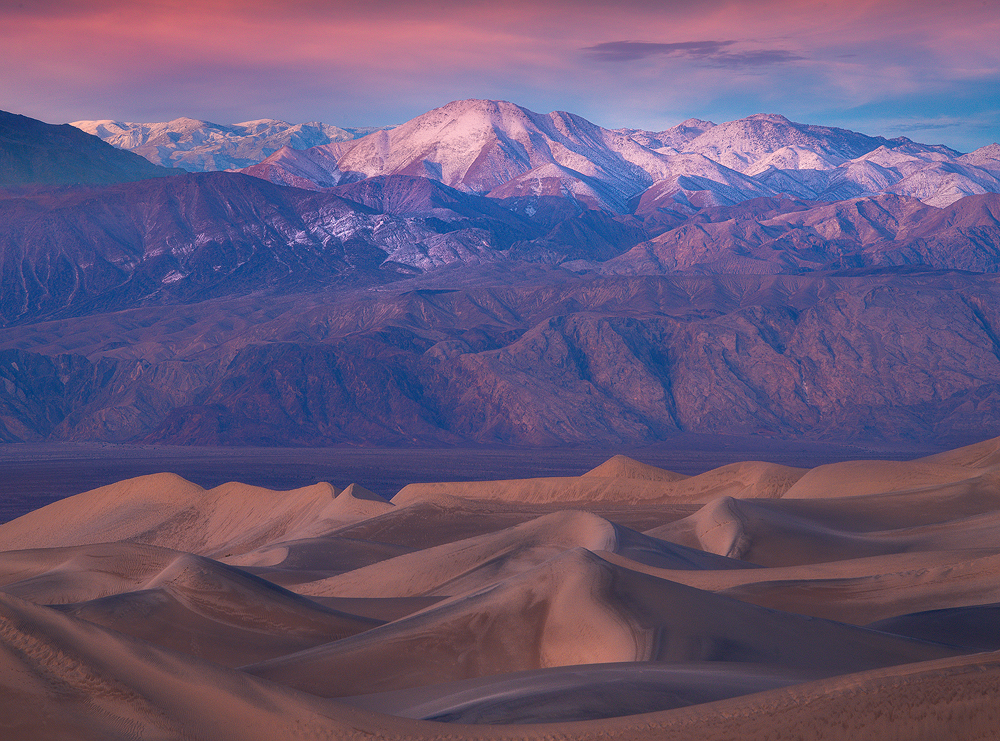
Twilight hour can create mood that is more subdued and peaceful. Images in the dunes don’t always have to be photographed right at sunrise or sunset
Always starts with a preconceived idea. Although the elements might be different, they complement one another to create the story. Organizing the details ahead of time allows you to break it down to the simplest terms. When it comes to composition, simple and organized is always the best course of action. It tells a story that makes sense to the viewer and leaves a lasting impression. The human mind craves structure and order, and when elements are connected, it gives the image purpose and direction. Visualize the items in a way that articulates your story. Creativity is so important when arranging the details.
A few essential concepts should outline how you place a composition. Firstly, balance and weight need to correct. It is crucial to make the main subject clear and dominant. All the other components should support the central element of the story. Look for parts in the foreground that stand out. Divide your image into a series of grids and placing the point of interest where the alliance on the great intersect commands attention and directs the eye away from the center of the frame, creating a more dynamic composition. With the subject of dunes, I always look to include sand ripples in the foreground. They provide strong leading lines and guide the viewer to the main subject. Generally, I like to get lower and closer to the foreground to accentuate size and depth.
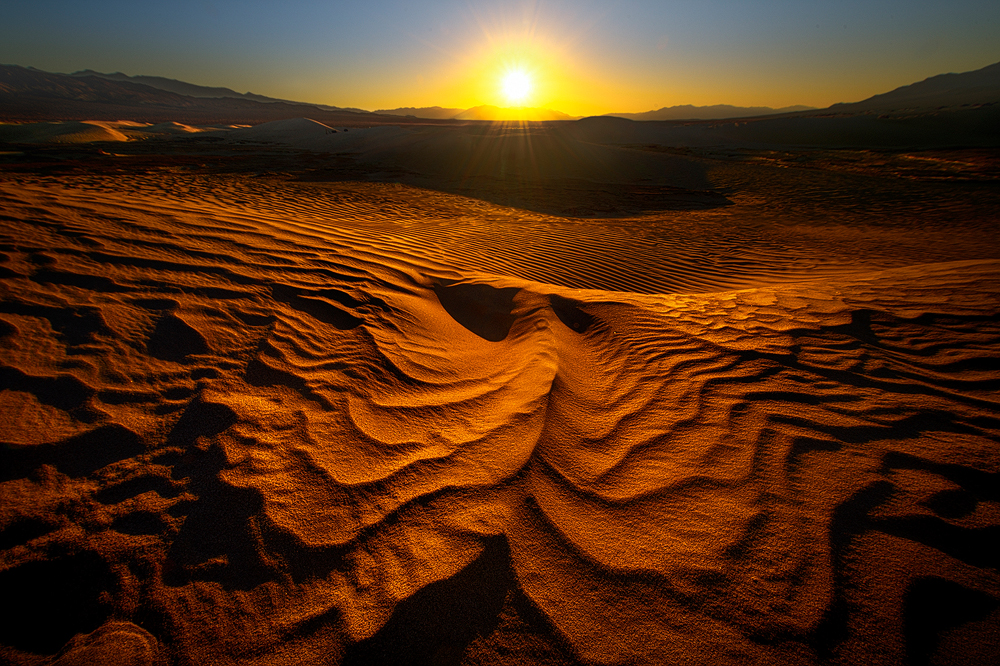
Always look for interesting patterns in the immediate foreground that will achieve immediate impact
Dominance within a composition is significant. The human brain scans a scene, focuses on what it finds attractive, and subconsciously disregards the rest. Move closer or use a lens to increase the subject’s size and let it fill the frame. Telephoto lenses are an excellent tool for isolating patterns in distant dunes. Select a camera positioned to isolate the subject from the messy or merging background. Try photographing an object from overhead or from below to isolate the subject. With dunes, get to the highest point above the dunes to give you a dominant perspective. A more elevated view for photographing dunes compresses the scene and includes only what is essential to the image. A low angle of the dunes will enable you to photograph the dunes looking straight up at the sky.
The sand ripples provide a strong leading line that guides the viewer to the top of the dunes and into the sky. Every object or element in a photograph has a particular visual weight, decided by shape, size, location and frame, color, and other properties. All of these come together to create balance. Be mindful of what to include and not include in the image. It is how you decide what you want to express by proportionally creating a relationship of elements in your scene. For example, you might want to make the feeling of a wide-open space by using a wide-angle lens.
Wide-angle lenses can exaggerate objects close to the lens to make them larger than they appear. A dynamic foreground sets the tone for the rest of the image. The next step is to think of depth and dimensionality to create layers within the image. With wide-angle photos, connect the elements in the picture. Frame the scene to include multiple layers and repeating patterns that recede into the background. An example of this could be similarly shaped dunes or sand ripples that converge in the distance. Repeating patterns leads to the topic of design templates.
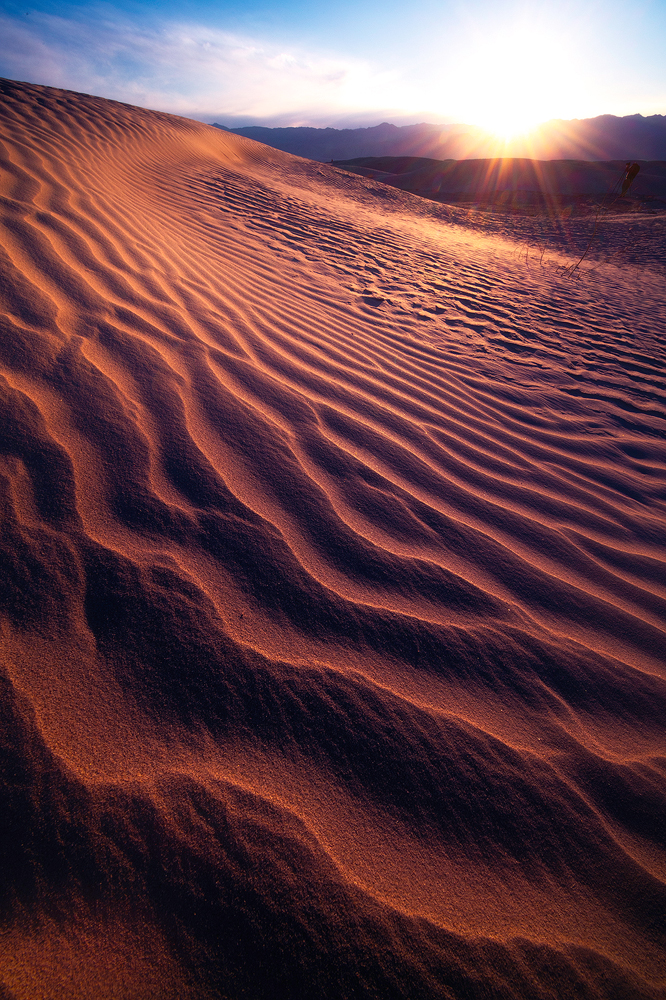
Receding sand ripples that become smaller in the background give the image dept. The placement of the sun anchors the image.
Design template is the theory that pictures project an idea, relationship, or concept by gathering different picture elements—a combination of visual themes and an optical center of interest. Visually arranging the composition in terms of patterns allows the image to tell a story in an organized manner that makes sense. Although visual templates could be an article in their own right, there are a few that work well with dunes.
The S-Curve pattern is one of the most common design patterns found in dunes. Using the contrast of light and shadow, S-curve can effectively connect all the elements in the image. The natural ebb and flow of dunes is the perfect design. The next design pattern that stands out in terms of composition is the juxtaposition of near/far elements. Intentional framing of a foreground subject that is in contrast to something similar in the background creates tension. It also creates depth in the image.
Receding elements is also another example of visual design for depth. Framing similar elements in the image that become increasingly smaller in the distance gives the viewer a sense of depth.
It’s essential to think outside of the box when it comes to creativity. The composition is one area where it’s necessary to follow the rules and know when to push the boundaries to create something different. Think in terms of creating different perspectives that evoke a mood. It is easy to get tunnel vision and become pre-occupied with one style and idea. Try things that bring you out of your comfort zone. Do not forget to frame both vertically and horizontally and think as well in terms of panoramically. The opposite holds as well, to think small and look for the finer details. There are no rules for photographing dunes, being creative, and remembering to tell a story that resonates with the viewer.
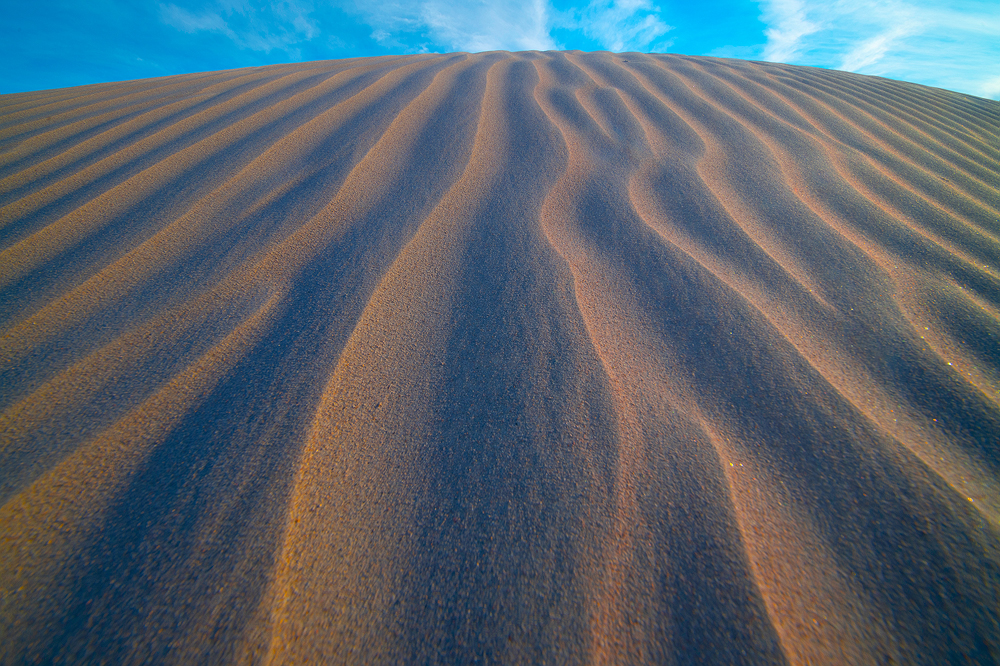
Light and shadow create dimension. The color harmony between warm and cool tones also adds visual interest.

Website: www.kevinmcnealphotography.com
Facebook: https://www.facebook.com/kevinmcneal30
Instagram: www.instagram.com/kevinmcneal30
Flickr: https://www.flickr.com/photos/kevinmcneal
Kevin McNeal is a landscape photographer who resides in the Pacific Northwest of the U.S. He focuses on grand colorful landscapes that reflect the most unique places on earth. Capturing moments of magic light and transferring this on print, images behold a combination of perseverance, patience, and dedication to capture the images in ways unseen before. The stories of how these images are rendered come across in the feelings the images convey.

Recent Comments